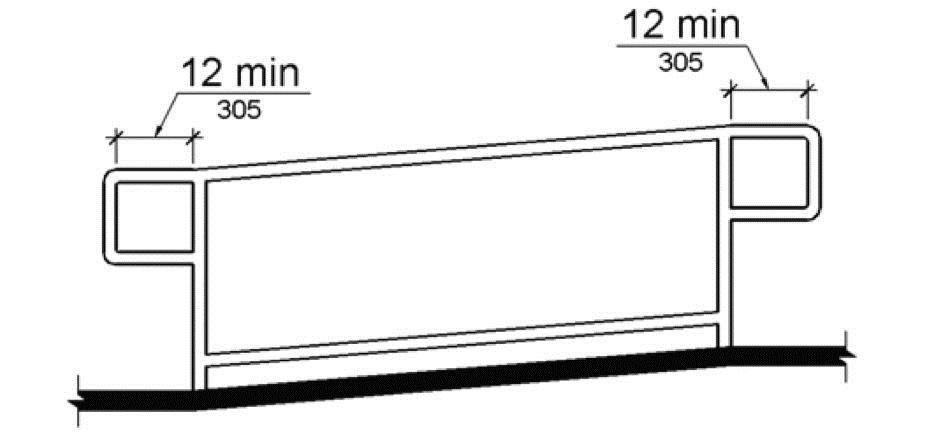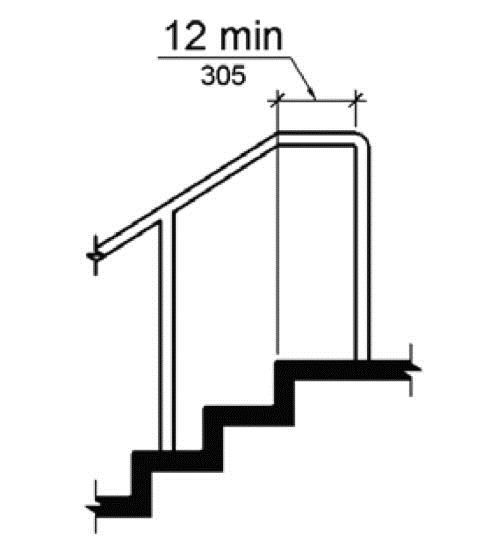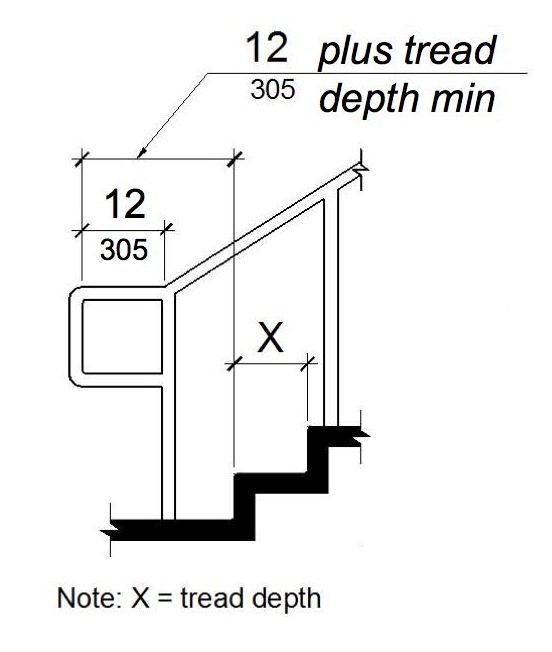2016 California Standards for Accessible Design Pocket Guide - Eff. Jan. 1, 2017
11B-505.10 Handrail extensions.
Handrail gripping surfaces shall extend beyond and in the same direction of stair flights and ramp runs in accordance with Section 11B-505.10.
Exceptions:
1. Extensions shall not be required for continuous handrails at the inside turn of switchback or dogleg stairs and ramps.
2. In assembly areas, extensions shall not be required for ramp handrails in aisles serving seating where the handrails are discontinuous to provide access to seating and to permit crossovers within aisles.
3. In alterations, where the extension of the handrail in the direction of stair flight or ramp run would create a hazard, the extension of the handrail may be turned 90 degrees from the direction of stair flight or ramp run.
[2010 ADAS] 3. In alterations, full extensions of handrails shall not be required where such extensions would be hazardous due to plan configuration.
ETA Editor's Note
CBC 11B-505.10 Exception 3 is more stringent than 2010 ADAS, which allows the handrail extensions to be eliminated in alterations where they would be hazardous. Handrail extensions are never permitted to turn 90 degrees at new stairs or new ramps, either by CBC or ADAS, except at continuous inside handrails (per Exception 1).
11B-505.10.1 Top and bottom extension at ramps.
Ramp handrails shall extend horizontally above the landing for 12 inches (305 mm) minimum beyond the top and bottom of ramp runs. Extensions shall return to a wall, guard, or the landing surface, or shall be continuous to the handrail of an adjacent ramp run.

FIGURE 11B-505.10.1
TOP AND BOTTOM HANDRAIL EXTENSION AT RAMPS
11B-505.10.2 Top extension at stairs.
At the top of a stair flight, handrails shall extend horizontally above the landing for 12 inches (305 mm) minimum beginning directly above the first riser nosing. Extensions shall return to a wall, guard, or the landing surface, or shall be continuous to the handrail of an adjacent stair flight.

FIGURE 11B-505.10.2
TOP HANDRAIL EXTENSION AT STAIRS
11B-505.10.3 Bottom extension at stairs.
At the bottom of a stair flight, handrails shall extend at the slope of the stair flight for a horizontal distance equal to one tread depth beyond the last riser nosing. The horizontal extension of a handrail shall be 12 inches (305 mm) long minimum and a height equal to that of the sloping portion of the handrail as measured above the stair nosings. Extension shall return to a wall, guard, or the landing surface, or shall be continuous to the handrail of an adjacent stair flight.
[2010 ADAS] 505.10.3 Bottom Extension at Stairs. At the bottom of a stair flight, handrails shall extend at the slope of the stair flight for a horizontal distance at least equal to one tread depth beyond the last riser nosing. Extension shall return to a wall, guard, or the landing surface, or shall be continuous to the handrail of an adjacent stair flight.

FIGURE 11B-505.10.3 ‡‡
BOTTOM HANDRAIL EXTENSION AT STAIRS
ETA Editor's Note
The CBC 11B-505.10.3 requirement for bottom handrail extension at stairs is more stringent than 2010 ADAS, which was revised from 1991 ADAAG.

User Comments/Questions
Add Comment/Question